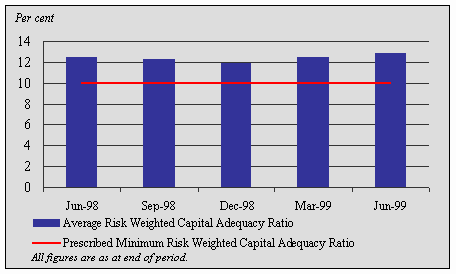
The Bank carries out the regulation and supervision of banks and deposit-taking activity of non-bank financial institutions under the provisions of the Banking Act 1988 and the Bank of Mauritius Act. It also regulates and supervises operations of money-changers and foreign exchange dealers in accordance with the provisions of the Foreign Exchange Dealers Act 1995.
Supervisory activity is entrusted to the Supervision Department of the Bank which is responsible for:
The Bank’s supervisory activity is guided primarily by considerations of the safe and sound operation of activities of institutions falling within its supervisory oversight and the protection of depositors’ interests in those institutions.
Ten domestic banks and ten offshore banks currently operate in the financial sector of Mauritius. No new domestic bank was licensed during the year 1998/99. In the offshore sector, the Deutsche Bank (Mauritius) Limited was licensed as the tenth offshore bank in operation in Mauritius.
Other than banks, seven non-bank financial institutions are authorised to carry out deposit-taking activity in Mauritius. The MUA Leasing Company Ltd was the seventh such company to be authorised to undertake deposit-taking activities during the year under review under section 13A(2) of the Banking Act 1988.
During the year ended 30 June 1999, one additional money-changer and two foreign exchange dealers were authorised to carry out business in Mauritius. As a result, three money-changers and two foreign exchange dealers were in operation as at 30 June 1999.
A list of banks, non-bank deposit-taking institutions, money-changers and foreign exchange dealers is shown in Appendix VI.
Domestic banks in Mauritius recorded significant growth in their operations in the year ended 30 June 1999.
Total assets of domestic banks expanded by 16.0 per cent to Rs96,514 million as at 30 June 1999 in line with the growth of 17.0 per cent recorded in the preceding year. For individual banks, the growth in assets ranged between 4.0 per cent and 29.1 per cent. Off-balance sheet assets, consisting of acceptances, documentary credits and guarantees, also experienced growth during the year, albeit at a lower pace of 8.1 per cent. Such assets amounted to Rs13,414 million at the end of June 1999.
Banks increased their foreign currency operations during the year. Foreign currency assets of domestic banks increased from Rs11,089 million as at 30 June 1998 to Rs14,855 million as at 30 June 1999. Banks' foreign currency assets represented 15.4 per cent of their total assets at the end of June 1999 as compared to 13.3 per cent at the end of June 1998.
Shareholders'/Head Office Funds went up by 13.7 per cent to Rs8,562 million at the end of June 1999, representing 8.9 per cent of total funds of domestic banks. Part of the higher capital was accounted for by the injection of core capital by banks in January 1999.
Total advances, including debenture financing, grew at a significant pace, rising by 20.0 per cent to Rs60,790 million as at end-June 1999 and represented 63.0 per cent of total domestic bank assets as compared to 61.0 per cent as at end-June 1998.
Deposits, which grew at a lower pace than advances, increased by 13.7 per cent to Rs75,811 million at the end of June 1999. In the previous year, deposits had gone up by 17.5 per cent. Deposits accounted for 78.5 per cent of banks’ total funds at the end of June 1999 as compared to 80.1 per cent at the end of June 1998.
The effects of the reduction of the non-cash liquid assets ratio from 20 per cent to zero per cent in July 1997 continued in the year under review. Investment by banks in Government securities declined from Rs15,203 million at the end of June 1998 to Rs11,842 million at the end of June 1999. As a proportion of total domestic bank assets, such investments dropped from 18.3 per cent as at 30 June 1998 to 12.3 per cent as at 30 June 1999.
In line with international developments in banking, banks in Mauritius are adopting ways of improving services to their customers.
Several domestic banks are operating on-line, real time links with their branches. One bank introduced an internet-based banking service for its customers during the year under review.
The use of electronic banking and plastic money continued to expand. As at 30 June 1999, there were 196 Automated Teller Machines (ATMs) in operation. In June 1999, over 1.2 million transactions amounting to Rs1.8 billion were executed through the use of credit cards, debit cards and other similar instruments. Some banks have established a system of on-line sharing of their ATM facilities with other banks.
Several banks have diversified their activities into other business areas. They have subsidiaries or significant interests in leasing, stock brokerage and fund management. Some banks have established international presence through subsidiary or branch operations in other countries.
Legislative and Regulatory Changes
Several legislative and regulatory changes were effected during the year to enhance the operational efficiency of banks.
Section 2 of the Banking Act 1988 was amended to redefine "offshore banking":
"offshore banking" means banking business or investment banking business conducted in currencies other than the Mauritian rupee except to the extent permitted by the central bank for trading on the foreign exchange market of Mauritius and investment in money market instruments.
Section 26(2) of the Mauritius Offshore Business Activities Act 1992 was amended to enable an offshore company to open and maintain with a domestic bank an account in foreign currencies with the approval of the Bank of Mauritius.
Several legislative initiatives are currently under way to update and modernise the legal framework governing financial institutions with a view to enhancing the safety and soundness of their operations and protecting the interests of depositors. These comprise:
The Banking Act 1988 was amended by the Finance Act 1997/98 to increase the minimum assigned capital/paid-up capital maintained by domestic banks to Rs100 million effective 1 January 1999. Also, the minimum capital for offshore banks was raised to US$4.5 million or the equivalent in any freely convertible currency. In compliance with these requirements, all banks have met the threshold effective 1 January 1999.
The Mauritius Code of Banking Practice prepared by the Bank in collaboration with commercial banks became effective on 1 July 1998. The main objective of the Code is to ensure that banks act fairly, reasonably and responsibly in all their dealings with customers and, hence, increase transparency by helping customers understand how their accounts operate and what they can reasonably expect from banks.
Five prudential guidelines governing the operations of commercial banks are currently in effect as follows:
(i) Guidelines on Limitation on Concentration of Risk;
(ii) Guidelines on Risk Weighted Capital Adequacy Ratio;
(iii) Guidelines on Income Recognition and Classification of Loans and Advances
for Provisioning Purposes;
(iv) Guidelines on General Principles for Maintenance of Accounting and other Records and Internal Control Systems; and
(v) Guidelines for the Calculation and Reporting of Foreign Exchange Exposures of Banks.
Initiatives are under way to revise some of these guidelines. A new guideline on liquidity management is currently under preparation.
The Basel Committee on Banking Supervision of the Bank for International Settlements (BIS) has recently released a consultative paper for revision of the existing Capital Accord. The Bank of Mauritius has invited all commercial banks to comment on the consultative paper.
The Bank of Mauritius has endorsed the set of 25 core principles for effective banking supervision as set out by the Basel Committee on Banking Supervision. These core principles are summarised in Box 3.
Bank performance is reviewed with respect to the following five elements:
Risk Weighted Capital Adequacy Ratio
The Bank of Mauritius caused the Basel Capital Accord requirements to be implemented by banks effective November 1993. The minimum risk weighted capital adequacy ratio, which was initially set at 8.0 per cent, was raised to 9.0 per cent effective 1 January 1997 and to 10.0 per cent effective 1 July 1997.
The risk weighted capital adequacy ratio of domestic banks, on average, fluctuated marginally during the year and stood at 12.8 per cent as at end-June 1999. The ratio varied widely between individual banks, principally because of the differences in the nature of their operations as well as differences in their operating policies and strategies. The ratio ranged from 10.6 per cent to 69.1 per cent during the quarter ended 30 June 1999.
Table 2.1 shows the risk weighted capital adequacy ratio of domestic banks. Chart 2.1 shows the quarterly positions of banks’ risk weighted capital adequacy ratios as at end-June 1998 through end-June 1999. Chart 2.2 shows the ratio of Tier 1 and Tier 2 capital to risk weighted assets over the same period.
Chart 2.1: Risk Weighted Capital Adequacy Ratio

Chart 2.2: Ratio of Tier 1 and Tier 2 Capital to Risk Weighted Assets
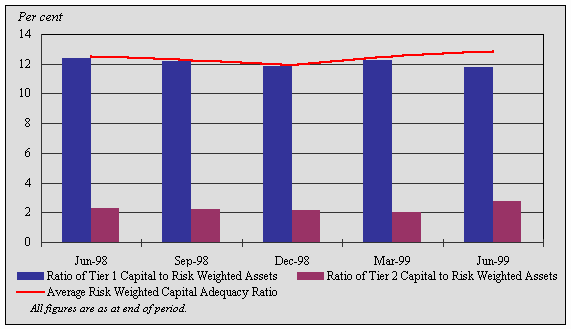
Between June 1998 and June 1999, the total capital base of domestic banks increased by 21.6 per cent from Rs7,092 million to Rs8,627 million, respectively. This rise was mainly attributable to increases in banks’ Tier 1 Capital.
Table 2.1: Domestic Banks: Risk Weighted Capital Adequacy Ratio

For the quarter ended June 1999, Tier 1 capital constituted 78.2 per cent of the total capital base of banks while Tier 2 capital constituted the remaining 21.8 per cent. Tier 1 capital for the corresponding period of the previous year was 81.4 per cent.
High-risk assets of domestic banks as a proportion of total assets stood at 59.4 per cent at the end of June 1999 as compared to 58.5 per cent at the end of June 1998. Zero-risk assets declined from 26.4 per cent as at 30 June 1998 to 22.3 per cent as at 30 June 1999, largely due to the lower levels of Government securities in banks' portfolios resulting from the reduction of the non-cash liquid assets ratio from 20 per cent to zero per cent in July 1997.
In July 1996, guidelines for the calculation and daily reporting of foreign exchange exposures were issued to domestic banks with a view to ensuring that their foreign exchange positions are managed in a prudential way. Banks are required to observe a daily overall foreign exchange exposure limit not exceeding 15 per cent of Tier 1 capital as from April 1997.
The Bank of Mauritius also monitors on a monthly basis the maturity pattern of banks’ foreign currency assets and liabilities as from March 1998. Data indicate that the banks are not unduly exposed to short-term capital mismatch and are, in general, managing their foreign currency positions in a prudential way.
Table 2.2 shows the maturity pattern of foreign currency assets and liabilities of domestic banks for the quarters ended 31 March and 30 June 1999.
Table 2.2: Maturity Pattern of Foreign Currency Assets and Liabilities
(Rs million)

Concentration of Risk and Large Exposures
Under section 21 of the Banking Act 1988, banks are required to report to the Bank of Mauritius on a quarterly basis credit facilities extended to any one customer or group of closely related customers where such facilities exceed 15 per cent of their capital base. Where credit facilities exceed 30 per cent of a bank’s capital base, the bank is required to inform the Bank of Mauritius prior to the extension of the facility. In case the credit facility is to exceed 50 per cent of its capital base, the bank is required to obtain the prior written permission of the Bank of Mauritius. No aggregate limit has so far been imposed on large exposures taken by individual banks but this prudential measure is currently being envisaged given the increasing exposures taken by individual banks.
Credit concentration in the domestic banking sector continued to be high. As at 30 June 1999, total fund and non-fund based facilities, beyond the threshold of 15 per cent of a bank’s capital base, totalled Rs23,965 million, representing 32 per cent of the overall on and off-balance sheet commitments of domestic banks. The corresponding ratio in June 1998 was 29 per cent.
The Guidelines on Income Recognition and Classification of Loans and Advances for Provisioning Purposes require that banks set aside specific provisions for advances representing more than a normal risk of loss. This determination is supported by specific minimum criteria based on the number of days the instalments of principal and/or interest are overdue.
The guidelines also require that banks maintain a minimum general provision of not less than one per cent in respect of their performing advances.
In view of the preponderance of credit activity in banking operations in Mauritius, the determination of non-performing loans and provision for bad and doubtful debts is an important tool of risk assessment and risk management for banks.
Domestic banks' non-performing advances increased from Rs2,717 million in 1996/97 to Rs3,496 million in 1997/98 and further to Rs4,774 million in 1998/99. As a percentage of banks' total advances, their non-performing advances went up from 7.8 per cent in 1996/97 to 9.0 per cent in 1998/99.
In the year ended 30 June 1999, provisions (inclusive of general provisions) for bad and doubtful debts amounted to Rs1,834 million as compared to Rs1,760 million in the preceding year. As a proportion of banks’ total advances, the amount of outstanding provisions dropped from 3.5 per cent at the end of June 1998 to 3.0 per cent at the end of June 1999.
The charge to the income statement of the banking sector for bad and doubtful debts dropped by 15 per cent from Rs438 million to Rs374 million for the period ended 31 March 1999.
Table 2.3 shows the charge for bad and doubtful debt and total advances of domestic banks for the period 1995/96 through 1998/99.
Table 2.3: Domestic Banks: Charge for Bad and Doubtful Debts and Total Advances 1

The financial year of three domestic banks ends on 30 June, that of one bank on 31 March while the remaining six banks close their accounts on 31 December. Pre-tax profits of domestic banks amounted to Rs1,953 million for 1998/99, up by 39.1 per cent or Rs549 million from those of 1997/98.
Table 2.4 shows the consolidated profit performance of all domestic banks. Their consolidated profit performance, combining the results for their various financial year-ends, is shown under the caption 1998/99 with comparative data for 1997/98.
Table 2.4: Domestic Banks: Consolidated Profit Performance
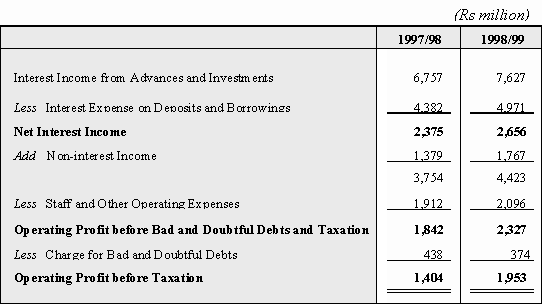
Charts 2.3 and 2.4 depict the components of income and the components of net interest income for domestic banks, respectively, for the period 1994/95 through 1998/99.
Chart 2.3: Domestic Banks: Components of Income
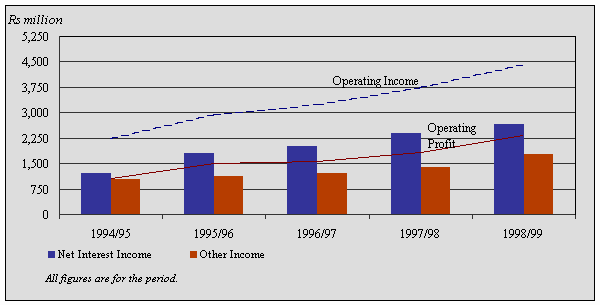
Chart 2.4: Domestic Banks: Components of Net Interest Income
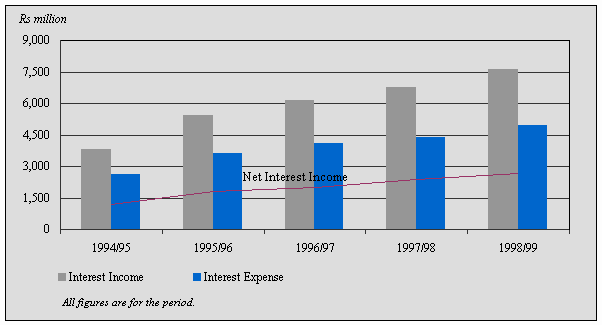
The increase in net interest income was a major contributor to the improved profit performance of banks for the period ended 31 March 1999. Interest received on advances and investments net of interest paid on deposits and borrowings amounted to Rs2,656 million for the period ended 31 March 1999 as compared to Rs2,375 million for the period ended 31 March 1998.
The above performance was achieved in spite of the decline in the interest spread from 5.83 per cent in 1997/98 to 4.90 per cent in 1998/99.
Other income, consisting principally of profits from foreign exchange transactions, fee income and income from investments, increased by Rs388 million, or 28.1 per cent, to Rs1,767 million in 1998/99. The main contributors to this increased profitability were a rise in both foreign exchange activity and investments.
Another measure of profitability is the return on average assets of domestic banks. The pre-tax return on average assets for all domestic banks increased from 2.07 per cent in 1997/98 to 2.45 per cent in 1998/99. However, the performance of individual banks was mixed, ranging between 0.52 per cent and 4.25 per cent. Four banks had a pre-tax return of over 2.0 per cent during 1998/99.
The post-tax return on average equity of domestic banks also improved significantly. In 1998/99, the return was 20.15 per cent as compared to 15.67 per cent in 1997/98. As for individual banks, the post-tax return on average equity in 1998/99 ranged between 4.51 per cent and 26.43 per cent as compared to the range of 5.56 per cent and 31.86 per cent in 1997/98.
Chart 2.5 shows the return on average equity and on average assets for domestic banks for the period 1994/95 through 1998/99. Table 2.5 provides a summary of domestic banks' financial performance in 1997/98 and 1998/99.
Chart 2.5: Domestic Banks: Return on Average Equity and on Average Assets
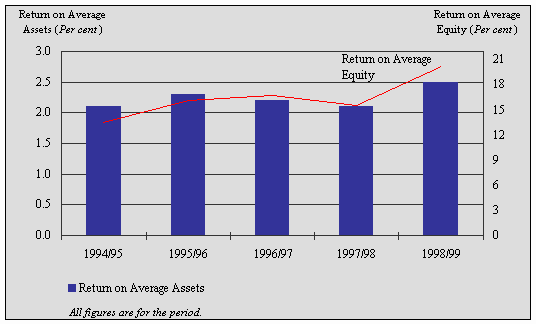
Table 2.5: Domestic Banks: Financial Performance

Chart 2.6 shows the consolidated operating profit and the profit after tax of domestic banks for the period 1994/95 through 1998/99.
Chart 2.6: Domestic Banks: Consolidated Operating Profit and Profit after Tax
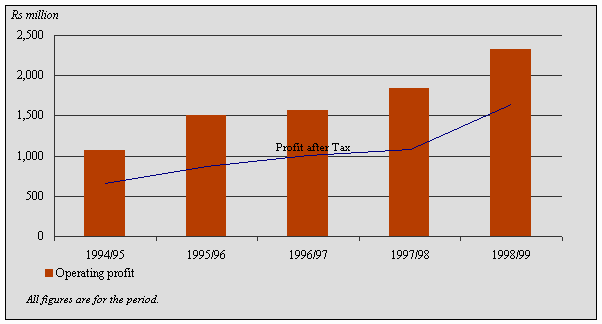
Offshore banks in Mauritius provide a variety of services in currencies other than the Mauritian rupee. These services include deposit-taking, foreign exchange dealing, lending, trade financing, fund management, offshore trust and securities custodial services. The offshore banking sector was established following the Government strategy to enhance and facilitate the provision of international financial services and to develop Mauritius into a full-fledged international financial centre.
The offshore banking sector continued its sustained growth in business in 1998/99. Total assets of offshore banks increased by 152 per cent to US$2,574 million at the end of June 1999, higher than the growth of 28 per cent and 44 per cent recorded in 1996/97 and 1997/98, respectively.
Offshore banks increased their placement of funds with other banks by US$896 million to US$1,624 million at the end of June 1999. Lending to non-bank customers also went up by US$604 million to US$830 million at the end of June 1999. Their investments almost doubled from US$59 million to US$104 million during the same period.
Chart 2.7: Offshore Banks: Total Funds and Net Profit
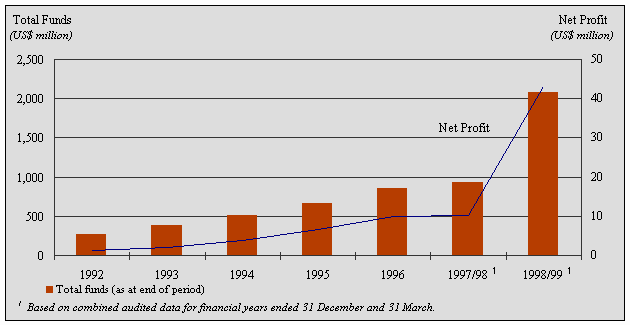
Borrowings from the international money market and deposit-taking from non-bank customers acquired greater significance as sources of funds for offshore banks in 1998/99. Borrowings increased from US$159 million in 1997/98 to US$1,068 million in the year under review. Deposits grew by US$440 million, or 67.6 per cent to US$1,091 million, at the end of June 1999.
The financial year-end of seven offshore banks is 31 December, of two offshore banks 31 March, while the tenth offshore bank started operations on 1 June 1999. The consolidated position of profit and loss accounts of all offshore banks, involving different financial year-ends, is referred to as 1998/99.
Interest earned by offshore banks on placements with other banks increased by US$48.6 million from US$28.6 million in 1997/98 to US$77.2 million in 1998/99 and accounted for 68.6 per cent of gross income. Interest on loans and advances to non-bank customers increased by US$12.4 million to US$24.1 million from US$11.7 million during the same period. Interest earned on investments in 1998/99 remained approximately the same as in the previous year at US$2.7 million. Other income, including fees and commission, amounted to US$8.5 million in 1998/99 and represented 7.6 per cent of gross income.
Chart 2.8: Offshore Banks: Non-Bank Deposits, Loans and Advances to Non-Bank Customers and Placement with Other Banks
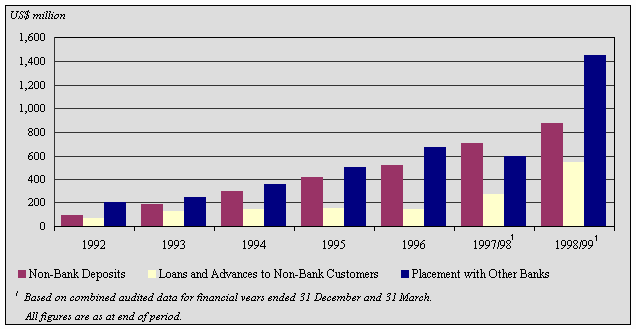
As a result of heightened money market operations of offshore banks, interest paid on money market borrowings increased by US$14.6 million to US$22.7 million in 1998/99. Interest paid on deposits of non-bank customers was US$40.3 million as compared to US$24.6 million in the previous year.
The nine offshore banks that were in operation during the whole year recorded net profits. Aggregate net profits for the offshore banking sector rose to US$43.4 million in 1998/99, from US$10.1 million in the previous year.
The aggregate pre-tax return on average total assets for the offshore banking sector was 3.11 per cent in 1998/99 as compared to 1.39 per cent in 1997/98. For individual banks, such return ranged from 0.56 per cent to 9.02 per cent in 1998/99.
Table 2.6: Offshore Banks: Profit Performance
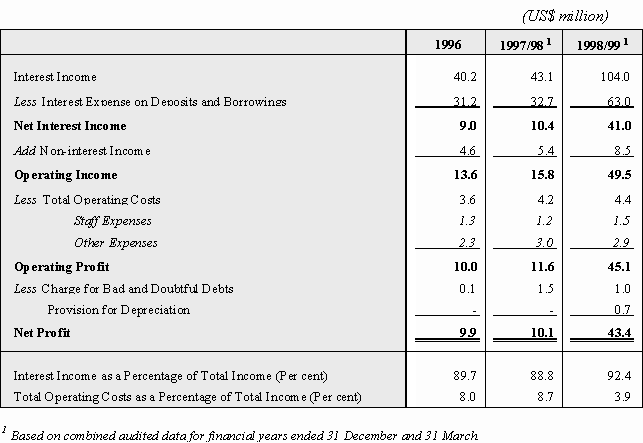
The aggregate return on average equity for the offshore banking sector, however, declined from 10.2 per cent in 1997/98 to 8.0 per cent in 1998/99, primarily because of the additional capital injected by the offshore banks.
Table 2.6 gives the profit performance of offshore banks from 1996 through 1998/99. Chart 2.7 shows the total funds and net profit of offshore banks for the years ended December 1992 through 1998/99. Chart 2.8 depicts non-bank customer deposits, loans and advances to non-bank customers, and placement with other banks for the years ended December 1992 through 1998/99.
Year 2000 Preparations in the Banking Sector of Mauritius
The critical role of basic infrastructure, including IT based systems, for carrying out financial transactions need not be over-emphasised. Recognising the threat posed by the Year 2000 Problem, chiefly in view of sectoral and international interdependencies, the Bank of Mauritius launched as from May 1997 an awareness campaign regarding this problem. The technical and business issues involved were highlighted, calling for an early remediation of the latent problem in banks’ systems with a view to guaranteeing operational continuity and maintaining a high level of confidence in the banking system of Mauritius.
The awareness campaign proved to be a success. As from July 1997, the Bank started monitoring implementation programmes of banks on a monthly basis at the level of individual institutions. A standard questionnaire, related to identification, planning, implementation, testing and certification by suppliers of Year 2000 issues, was used for this purpose.
Monthly progress monitoring of individual banks was linked initially to a target date of 31 December 1998 for Year 2000 compliance by the entire banking system. The speed of implementation of the Year 2000 project by individual banks varied depending on the size of the banks in some cases and the seriousness with which the management of some other banks addressed the issue. Inevitably, the rather tight deadline of 31 December 1998 was missed and was extended thereafter successively to 31 March 1999 and 30 June 1999 in the light of progress achieved by individual institutions.
By March 1999, 10 out of the 20 banks in operation, representing 39 per cent of the total banking business of the country, reported having shifted over the full range of their operations to their Year 2000 compliant version. By June 1999, the number of banks having completed and changed over to the compliant version increased to 19 and the last bank to report that it had shifted over to its compliant version did so by mid-July 1999. Thus, all banks operating in Mauritius have reported that they have completed work on the project, tested and shifted over to their Year 2000 compliant versions.
As part of its supervisory work, the Bank of Mauritius has, in the course of its ongoing on-site examination of banks, been overseeing, together with the management of banks, the functioning of banks’ Year 2000 compliant versions.
On the whole, the Bank is satisfied that remediation of the systems has been satisfactorily carried out by individual banks and that the risk posed to the financial infrastructure of Mauritius as regards the banking system has been properly addressed.
The Bank of Mauritius embarked on its Year 2000 project in May 1997. In the past two years, all its systems, including non-IT items, have been reviewed and remedial action taken followed by testing. Suppliers of key system have provided statements to the effect that their products in use in the Bank’s system are Year 2000 compliant. The Bank achieved full compliance by 30 June 1999.
While adequate steps have been taken by banks to address the risks of material disruption of their operational infrastructure, there remains a possibility that unanticipated glitches may arise either in the internal systems of banks themselves or due to problems originating outside of banks, which may affect business continuity associated with the millennium date change. Accordingly, parallel actions have been initiated to mitigate such risks and to contain the consequences of any disruption occurring due to such factors so as to ensure business as usual past the millennium date change.
Two banks have completed their contingency plans to cope with such emergencies. The rest of the banking system is due to have completed their contingency plans not later than 30 September 1999. As regards the Bank of Mauritius, its contingency planning is in the process of being finalised whereupon testing will be proceeded with. The deadline for the Bank’s contingency plan is the 30 September 1999.
The Bank of Mauritius has taken other actions in order to increase the banking system’s preparedness for Year 2000 compliance. Thus, steps have been taken to declare 31 December 1999 a bank holiday under section 41 of the Banking Act 1988. The Bank has also made arrangements for an ample supply of banknotes to meet the needs of the millennium change and is working, in this connexion, in close consultations with banks to ensure that any extra supplies of banknotes in response to demand are duly met and liquidity issues are addressed well in time. Adequate measures have accordingly been taken to ensure a smooth transition to the new millennium.
OTHER SUPERVISORY DEVELOPMENTS
Fourth Senior Bank Supervisors World Bank/IMF Workshop and Seventh ESAF Annual General Meeting
Banking supervisors from the sixteen supervisory authorities of the eastern and southern African regions are grouped together in the Eastern and Southern Africa (ESAF) Banking Supervisors Group as from 1993.
The Bank of Mauritius hosted the Fourth Senior Bank Supervisors World Bank/IMF Workshop of the Eastern and Southern Africa Banking Supervisors Group from 14 to 18 June 1999 and the Seventh Annual General Meeting of the ESAF Banking Supervisors Group from 21 to 23 June 1999.
The principal objectives of the ESAF Supervisors Group are to promote and enhance the quality and nature of banking supervision and to harmonise banking supervision practices in the region. In line with these objectives, the main focus of the workshop was on the challenges posed by the changing global banking environment.
The workshop was conducted by resource persons from the World Bank and the IMF and was attended by twenty-eight delegates from 15 countries in the ESAF region. Topics covered included:
The workshop was of assistance in keeping the banking supervisors in the ESAF region abreast of the latest developments in the field of supervision of banks.
The Annual General Meeting of ESAF was held in Mauritius from 21 to 23 June 1999. Challenges to banking supervision in the next millennium was one of the key subjects discussed in the course of the AGM as well as actions taken/to be taken so as to achieve regional harmonisation of supervisory standards. Supervisors from the following Central Banks will be members of the ESAF Executive Committee during the coming two years: Mauritius (Chairperson), South Africa (Secretariat), Zimbabwe, Tanzania, Botswana and Zambia.
|
Set of 25 Core Principles Effective Banking
Supervision as set out by the Basel Committee on
The 25 Core Principles for Effective Banking Supervision were proposed by the Basel Committee on Banking Supervision in 1997. Several supervisory authorities, including the Bank of Mauritius, have adopted these Core Principles as the basis for carrying out their supervisory work. The main objective of the Core Principles is to reinforce and harmonise international supervisory standards with the aim of dealing eventually with systemic risks posed by disparities in standards of bank supervision among different jurisdictions.
The Core Principles deal with preconditions that supervisory authorities need to satisfy so as to be able to carry out effective banking supervision, the standards and criteria to be applied in the licensing of banks, the setting out and implementation of prudential regulations by supervisory authorities and their enforcement through off-site monitoring and on-site examinations. They give the mechanism that supervisors should put in place to gather and disseminate information on the activities of banks, including the carrying out of consolidated supervision involving cross-border operations of banking institutions. They also require supervisors to have the necessary means at their disposal to deal effectively with banks that fail to meet regulatory and prudential requirements. Below is presented an outline of the 25 Core Principles for Effective Banking Supervision. 1. An effective system of banking supervision will have clear responsibilities and objectives, operational independence, adequate resources, a suitable legal framework and suitable arrangement for the sharing of information with other supervisors. 2. The activities of institutions that are licensed and subject to supervision as banks must be clearly defined and the use of the word "bank" should be restrictively used. 3. The licensing authority must set criteria and standards for bank licensing. These include a banking organization’s ownership structure, its directors and senior management, its operating plan and internal controls and projected financial condition including its capital base. Where the proposed owner or parent organization is a foreign bank, the prior consent of its home country supervisor should be obtained. 4. Banking Supervisors must have specific powers to approve significant ownership transfers and any controlling interests in existing banks to other parties. 5. Banking Supervisors should have authority to approve major acquisitions or investments by a bank and ensure that corporate affiliations or structures do not expose the bank to undue risks or hinder effective supervision. 6. Banking supervisors must set minimum capital requirements for banks and must define the respective components of capital. 7. Banking supervisors must have independence in evaluating bank’s policies, practices and procedures for granting loans and investments and also performance of the loan and investment portfolios. 8. Banking supervisors must ensure that banks have adequate policies, practices and procedures for evaluating the quality of assets and the adequacy of loan loss provisions and reserves. 9. Banking supervisors must set prudential limits to restrict bank exposures to single borrowers or groups of related borrowers. 10. Banking supervisors must ensure that lending by banks to insiders and related parties is at arms length and is well monitored and that steps are taken to control or mitigate the risks arising from such transactions.
11. Banking supervisors must ensure that banks have adequate policies for identifying, monitoring and controlling country risk and transfer risk in their international lending and investment activities, and also for maintaining adequate reserves against such risks. 12. Banking supervisors should set limits and/or specific capital charge on market risk exposures and banks should have adequate measures to monitor and control market risks. 13. Banking supervisors must ensure that banks have a comprehensive risk management process to identify, measure, monitor and control all other material risks and, where appropriate, to hold capital against these risks. 14. Banks must have adequate internal controls and appropriate independent internal or external audit and compliance functions to test adherence to these controls as well as applicable laws and regulations. 15. Banks should have adequate policies to promote high ethical and professional standards in the financial sector and prevent the bank being used, intentionally or unintentionally, by criminal elements. 16. An effective banking supervisory system should consist of both on-site and off-site supervision. 17. Banking supervisors must have regular contact with bank management and thorough understanding of the institution’s operations. 18. Banking supervisors must have a means of collecting, reviewing and analysing prudential reports and statistical returns from banks on a solo and consolidated basis. 19. Banking supervisors must have independence in validation of supervisory information either through on-site examinations or use of external auditors. 20. Bank supervisors should have the ability to supervise the banking organisation on a consolidated basis. 21. Banking supervisors must ensure that banks maintain adequate records and that they publish on a regular basis financial statements that fairly reflect their conditions. 22. Banking supervisors must have measures to bring about corrective action when banks fail to meet prudential and regulatory requirements. 23. Banking supervisors must practise global consolidated supervision, adequately monitoring and applying appropriate prudential norms to all aspects of the business conducted by banking organizations worldwide, primarily at their foreign branches, joint ventures and subsidiaries. 24. For effective global consolidated supervision, banking supervisors must maintain contacts and information exchange with other supervisors and, more importantly, the host country supervisory authorities. 25. Banking supervisors must ensure a uniform supervision standard for both domestic and foreign institutions and must have powers to share information needed by the home country supervisors for the purpose of carrying out consolidated supervision. |